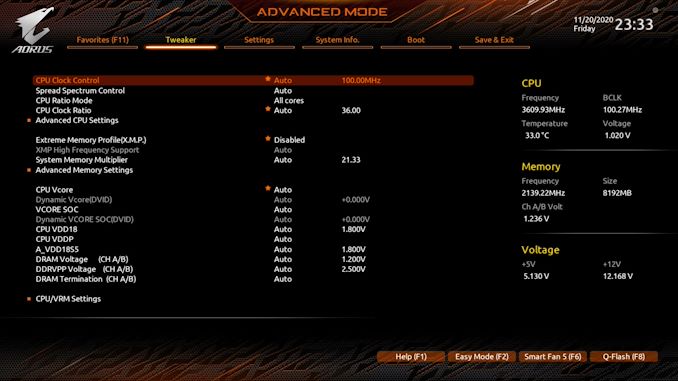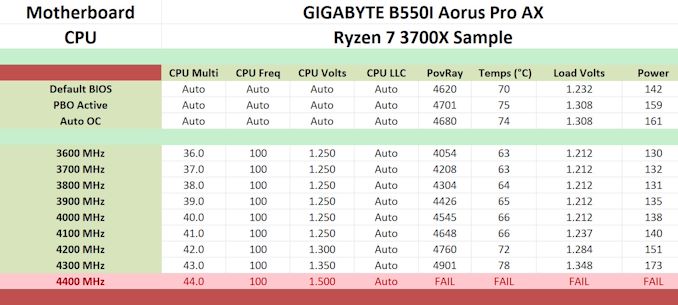The GIGABYTE B550I Aorus Pro AX Motherboard Review: All The Small Things
by Gavin Bonshor on December 7, 2020 10:00 AM ESTOverclocking Ryzen 3000
Experience with the GIGABYTE B550I Aorus Pro AX
When it comes to overclocking AMD's Ryzen 3000, pushing them to even modest all-core frequencies can mean they run very hot. Even with the most recent Zen 3 based Ryzen 5000 processors, Robert Hallock, who is AMD's Director of Technical Marketing, stated in response to a Redditor that they (Ryzen 5000) could quickly hit up to 95 degrees Celsius under full-load. According to Robert Hallock, this is a part of the design and should allow the Ryzen 5000 series chips to boost longer due to the higher temperature threshold, thus giving better performance all across the board. It is recommended that users looking to overclock Ryzen 3000, or even contemplate using the Ryzen 5000 series, do invest in adequate CPU cooling with premium AIO closed-loop coolers looking like the most strong candidates outside of the expensive custom liquid solutions on the market.
Focusing on our experience with the GIGABYTE B550I Aorus Pro AX, the firmware itself is user friendly and responsive as far as a BIOS goes. All of the relevant overclocking settings can be found within the Tweaker section, with options to overclock the CPU, iGPU, and memory all found here. Users can use the CPU ratio mode to make adjustments to the core clock speed, while fine tweaking can be done via the base clock under the CPU Clock Control option. For voltages, the CPU VCore is the most prominent option for pushing more juice to the CPU, while options to change the level of Load-Line Calibration of the 8-phase power delivery can be found under the CPU/VRM settings.
Memory overclocking can be done multiple ways, with X.M.P 2.0 profiles available by enabling the profile on compatible memory for ease of use. Other options for tuning the memory manually with the System Memory multiplier, altering the DRAM voltage, and a section dedicated to tweaking the memory timings. As we've previously noted in previous AM4 reviews, AMD recommends a maximum FCLK (Infinity Fabric Clock) to within 2:1 of the memory frequency, with the sweet spot sitting at DDR4-3600 with an FCLK of 1800 MHz.
Overclocking Methodology
Our standard overclocking methodology is as follows. We select the automatic overclock options and test for stability with POV-Ray and OCCT to simulate high-end workloads. These stability tests aim to catch any immediate causes for memory or CPU errors.
For manual overclocks, based on the information gathered from the previous testing, start off at a nominal voltage and CPU multiplier, and the multiplier is increased until the stability tests are failed. The CPU voltage is increased gradually until the stability tests are passed. The process is repeated until the motherboard reduces the multiplier automatically (due to safety protocol) or the CPU temperature reaches a stupidly high level (105ºC+). Our testbed is not in a case, which should push overclocks higher with fresher (cooler) air.
We overclock with the Ryzen 7 3700X for consistency with our previous overclocking tests.
Overclocking Results
Equipped with a solid 8-phase power delivery, the mini-ITX GIGABYTE performs pretty competitively in our overclocking tests. Not only is the B550I Aorus Pro AX more than capable of pushing a Ryzen 3000 beyond its limits comfortably, but it behaves very well in regards to VDroop in our manual testing. Our AM4 testing with the Ryzen 7 3700X stretches starts from 3.6 GHz and goes as far as we can in the headroom. Although our Ryzen 7 3700X, unfortunately, cannot do 4.4 GHz fully stable, 4.3 GHz is still a good overclock all-cores.
Our POV-Ray benchmark performance increased as we tested each frequency from 3.6 GHz to 4.3 GHz, with solid levels of VDroop control when comparing load CPU VCore to the values set within the BIOS. Naturally, as we increased the frequency, we saw higher temperatures a full load, but not as much when we upped the CPU VCore from 1.25 V to 1.30 and beyond. Power also crept up as we increased the frequency and CPU VCore, which is expected as more juice means more power from the wall.












76 Comments
View All Comments
romrunning - Monday, December 7, 2020 - link
This board has been out for quite a while, and it's been proven to be a good buy. If you done any homework at all on mini-ITX B550 boards, you'll know it's one of the top ones.The main difference between this board and the other top competitors is that it doesn't have a Type-C front-panel port. That seems to be the main reason why it's a bit cheaper than the other boards. I can see Gigabyte adding it in a "v2" of the board, though. If your choice for a new mini-ITX case has that style of port available, it may factor into your decision.
gavbon - Monday, December 7, 2020 - link
Of course, I agree with you. It's why it's been highlighted as my go-to Mini-ITX model in our AMD motherboard guides.romrunning - Monday, December 7, 2020 - link
What's annoying is that we can get these great mini-ITX boards back in stock, but the rest of the new components are out of stock. My NR200 & this Gigabyte board was going to be the base of a new build, but everything else is not available. I'm not going to buy from over-priced eBay offers, so for now, patience is the key.Zagreus86 - Monday, December 7, 2020 - link
I'm in the same boat, except I have everything except the case at this point (NR200). Seems we can't get them into the UK for love nor money at the moment!Questor - Wednesday, December 9, 2020 - link
Where is my Ryzen 5900X? I swear it was right here just a minute ago. Did you see it?christinescoms - Saturday, December 12, 2020 - link
I get paid more than 120 to 130 per hour for working online. I heard about this job 3 months ago and after joining this i have earned easily 15k from this without having online working skills. This is what I do.....___bit.ly/googlework75calc76 - Monday, December 7, 2020 - link
Another big difference is how many high speed ports the Asus B550-I has vs the Gigabyte B550I has, not just the lack of front 10Gbps Type C. Gigabyte probably skimped to be cheaper there as well:Asus B550-I:
5 10Gbps
2 5Gbps
4 480Mbps
Gigabyte B550I:
2 10Gbps
6 5Gbps
2 480Mbps
mkarwin - Tuesday, December 15, 2020 - link
And another is how the "supreme surround sound" is done through analog outputs - Asus requires connecting 2 rear ports and front-panel line-out for 5.1 analog speakers, while Gigabyte utilises rear ports only...Quad5Ny - Friday, March 26, 2021 - link
When you see ONLY 3 audio ports on the rear these days its usually auto-switching. So you'll get 5.1 using the back panel and 7.1 if you use the back and front panel. -Skip the mic and line-in on the rear and consult your MB manual.ozark - Tuesday, December 8, 2020 - link
For this exact reason I op'ed for the MSI MPG B550I, which is listed for $200 but often on sale for $185 or lower on Amazon. When you are on an ITX build, every port is precious and a front panel USB-C port is immensely useful. It's bit a of shame that the MSI board uses slightly inferior setup for their audio or wifi solution, although for most people there's no detectable difference.